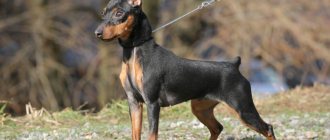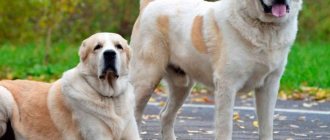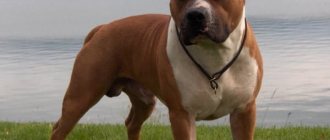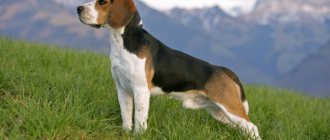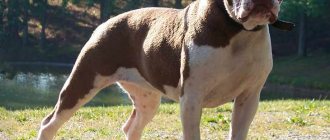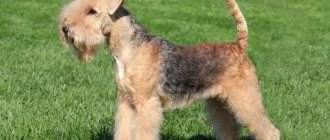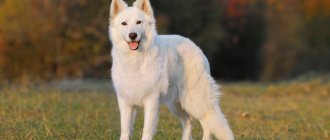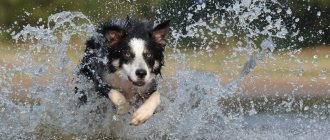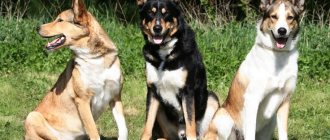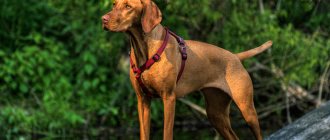Almost all dog owners have noticed how their four-legged friend tries the grass for a tooth while walking. Some people won’t pay attention to this, but others will worry – is the pet really lacking vitamins or is there something wrong with its health? It is still advisable to understand why a dog often eats grass, when it is safe, and when it will cause harm.
Why does a dog eat grass?
There are several reasons why a dog eats grass. You can get acquainted with them below.
Lack of fiber
If an animal eats an unbalanced diet, it suffers from a lack of fiber. This element is necessary for the quadruped for the normal functioning of the entire organism. According to observations, dogs whose owners feed high-quality food chew plants less often or do not pay attention to them at all.
Stomach cleansing
With a large amount of food, your pet may experience stomach discomfort. By eating greens, the weevil tries to induce vomiting and empty its stomach. Don't be alarmed if your dog eats grass and vomits it. But sound the alarm if your dog vomits several times after eating greens.
I like the taste
Our smaller brothers also have their own taste preferences, which can sometimes be strange. Some dogs just love the taste of greens. Therefore, in this case, a dog eating grass should not be alarming.
Play, especially in puppies
In puppyhood, dogs actively explore the world; they, like human children, want to put everything in their mouths. The puppy is also very interested in what every object that surrounds him tastes like.
Probable disease
The four-legged dog feels bad due to a number of diseases, so if the dog eats grass, it means that it wants to alleviate its condition a little. Observe your pet: does he show any other signs of illness (lack of appetite, lethargy, problems with bowel movements, etc.)?
Do not prevent your animal from eating outdoor vegetation if it feels fine afterwards. But pay attention if your pet eats greens too greedily. Sometimes owners may believe that their pet is so plaintively asking to go outside because it wants to go to the toilet.
But imagine their surprise when the pug runs headlong to a place overgrown with blades of grass and eats it like it was the last time. In this case, you better consult a veterinarian and ask him why the dog eats grass so frantically. It is quite possible that the dog liked the greens so much for a reason and will have to undergo a series of tests.
If your pet bothers you with its behavior while walking, try making adjustments to its diet first. Reduce the amount of meat, add more vegetables (except potatoes). Instead of cheap food that has virtually no vitamins and minerals, buy at least premium food.
Briefly about the main thing
- A dog starts eating grass mainly due to poor nutrition. This may be a lack of fiber or the need to improve digestion and cleanse the stomach.
- The dog may start eating grass just by playing and getting your attention. This poses no danger to him.
- The behavior of the grass in combination with other symptoms may be a signal of a serious illness. So, carefully monitor changes in your friend’s behavior and condition to prevent serious consequences.
Have you noticed this behavior in your pet? Do you allow eating grass? Share your experience in the comments.
Did you like the article? Share it with your friends on social media. networks. This will help them get useful information and support our project.
What grass can dogs eat?
Now it has become a little clearer why dogs eat grass and why they behave a little strangely. Now we need to find out which greenfinch can be safely eaten by weevils.
Most plants do not pose a threat to pets, but this does not mean that you can allow your ward to eat whatever he wants.
Here is a list of what the wet nose can safely eat:
- sow thistle;
- wheatgrass;
- nettle;
- Rowan;
- chamomile;
- calendula;
- beet or carrot tops;
- mint, dill, parsley;
- rose hip;
- milk thistle;
- linden flowers;
- Valerina;
- dandelion;
- sprouted rye, wheat and oats.
It is very important that the plants grow in an environmentally friendly place away from roads and factories - and are not treated with chemicals. Only then will it be safe for your dog to eat grass.
Diet control
Many owners do not know which grass is good for dogs, and leave the choice to the pet itself. Some animals have a passion for lawn and meadow grass. One of the most beneficial plants for dogs is chamomile. It relieves inflammation of the stomach and is effective for intestinal spasms.
If your dog eats grass, there are certain measures you need to take. It is important to ensure that the animal does not chew stems that are too hard with its teeth, which can damage the walls of the stomach. Dirty grass should also be discarded. What grass is good for dogs? Fresh and dry plants are suitable. It’s good if they grow away from the road, and even better - in the garden.
The presence of parasite eggs on green leaves prompts you to vaccinate your dog and monitor the intake of anthelmintic medications. Their cost must be high - cheap tablets are not 100% effective.
Veterinarians will wonder why dogs eat grass for a long time. Furry lovers can only create conditions for a carefree life for their pets.
What plants are dangerous?
When asked if dogs can eat grass, all veterinarians will tell you yes. But not just any plant will do. Adults usually feel that eating greens will make them feel bad, so they don’t risk trying them. But puppies and young animals may eat it purely out of curiosity.
The list of dangerous plants includes:
- horse chestnut;
- lupine;
- buttercup;
- buckwheat;
- poppy;
- clover;
- iris;
- horsetail;
- cornflowers;
- alfalfa;
- belladonna;
- henbane black.
If your pet does ingest a poisonous plant, you need to neutralize the poison as quickly as possible. It will be better if you take your four-legged animal to the veterinary clinic without delay.
But even if the wet-nose has eaten non-hazardous vegetation, there is a risk of infection by parasites, since there may be excrement of other animals on the surface of the greenery.
Is eating grass dangerous for dogs?
Eating grass in itself does not pose any danger to your pet.
Your dog knows very well which grass to choose and which to avoid. However, you must control this process. After all, a dog can eat grass treated with pesticides. Therefore, avoid areas near city flower beds or certain areas in parkland where there is a possibility that the grass has been treated for pests. Also avoid grass where slugs and snails are abundant. These creatures can cause helminths in an animal, and this is a serious problem that threatens the health and life of the animal. Should I limit my dog's grass intake? The simplest and most understandable answer to this question is: “No!” Eating grass is normal behavior for a dog, even if it is accompanied by vomiting. Eating grass will help the digestive system, ensure its normal functioning, and generally have an overall beneficial effect on the body.
You should only pay attention to the consequences of consuming grass. If this results in prolonged, severe vomiting, then you need to ask your veterinarian for advice about allowing your dog to eat grass. In all other cases, you don't need to worry! Although eating grass may seem strange to uninitiated people, it is a completely normal physiological behavior of the animal.
Herbal medicine for four-legged animals
Not only people are treated with herbs - they are ideal as a gentle therapy for dogs. In some cases, herbs can help faster and more effectively than medications. However, the appropriateness of such treatment must be confirmed by a veterinarian. If a four-legged animal is diagnosed with a serious illness, then traditional medicine fades into the background.
Non-dangerous sores can easily be cured with herbs, but only if you are sure that they will help your animal. Under no circumstances should you give plants that you are not sure are safe. If some infusion or mixture helped you, this does not mean that it will help your dog.
If your pet loves to eat street vegetation, try to walk it away from the roads. It will be much better if you start growing greenflies for your pet yourself. At least you will be sure that it is clean and safe, and if the dog is used to eating grass outside, he will probably stop doing it.
Herbal medicine for dogs
Herbal treatment, as well as other non-standard methods, can also be used for dogs. The effect of pharmaceutical herbs is milder than the effect of tablets and injections. The treatment is relatively safe, and in some cases, effective for certain protracted diseases. But herbal medicine cannot always help with a serious illness. Veterinarians may prescribe antibiotics in advanced cases. However, in case of acute attacks of the disease and serious infectious diseases, it is better to trust the experience of the doctors who will prescribe the medicine.
Often, non-standard medicine is resorted to when conventional therapy fails. Therefore, veterinarians use additional folk remedies. Naturally, in order not to expect an incredibly quick cure, it is necessary to remember that herbal treatment includes not only advantages, but also disadvantages. Therefore, if you are not sure about the action of plants, then you need to seek help from a doctor.
In your case, you may need medication treatment. So, those owners who decide to try herbal medicine should understand herbs and their effects on the animal’s body.
If you suspect a disease, it is best to consult a veterinarian
Attention! Don't count on human literature. Only a veterinarian can advise you on what to give your dog.
For example, consider some herbs and plants:
- Nettle leaves contain multivitamins and are prescribed as an anti-inflammatory agent. Do not use for dogs with kidney problems.
- Linden flowers contain carotene, vitamin C and are used as a diuretic.
- Rowan is an important medicinal raw material; its fruits and seeds contain provitamins A, sugar, glucose isomer, and sucrose. Used as a diuretic medicine.
- Rosehip activates the functions of the adrenal glands and promotes tissue restoration.
Let's look at the herbs that you can take, the dosage in the form of tables.
Table 1. For infusions
| Plant | Image | Application part | Amount of crushed raw materials Art. l. per glass of water | Amount of drug per dose for a small dog | Amount of drug per dose for a large dog | How much to take per day |
| Stinging nettle | Leaves | Two | Art. l. | Half a glass | 2 r. a day before meals | |
| Linden | Flowers | Three | Two tbsp. l. | Half a glass | 2 r. a day before meals | |
| Rowan | Fruit | Two | Art. l. | Half a glass | 2 r. a day before meals | |
| Rose hip | Fruit | One | Art. l. | Half a glass | 2 r. a day before meals |
Table 2. Tinctures (pharmaceutical preparations)
| Plant | Image | Amount of drug per dose for a small dog | Amount of drug per dose for a large dog | How much to take per day |
| Ginseng | Five drops | 20 drops | 2 times a day, half an hour before meals | |
| Schisandra chinensis | Seven drops | 30 drops | 2 times a day, half an hour before meals |
When should you contact a veterinarian?
If a four-legged animal ate green grass and remained just as active and restless after that, then there is no danger.
However, if he chewed vegetation and then vomited repeatedly, you should run to the vet immediately. Most likely, what was eaten was poisonous or toxic. The veterinarian will neutralize the effect of the poison and prescribe the correct treatment.
You should also sound the alarm if you observe the following symptoms after your dog eats grass:
- refusal to eat;
- lethargy, apathy, reluctance to do anything;
- elevated temperature;
- convulsions;
- blueness of mucous membranes;
- there is blood in the stool and vomit;
- constipation for a long time;
- constant diarrhea;
- sudden weight loss;
- change in coat (too hard, starting to shed heavily, excessively tousled, etc.);
- repeated vomiting.
These signs may indicate dangerous infectious diseases or poisoning. You definitely can’t do this without visiting a specialist.
Analogs from a pet store
Sprouted seeds of cereals and other crops are often sold in pet stores. You can be completely confident in the safety of this greenery. And if your pet doesn’t like the grass, you don’t have to throw it away. Transplant it into a larger pot and use it as a decorative element in your home.
The consultants in the store will tell you which greenback will suit your four-legged friend. They will also advise you on this or that plant if your dog has any health problems.
It would be a good idea to buy greens at any supermarket. This is about:
- Celery: Its stalk has anti-inflammatory properties. Indispensable for older pets suffering from arthritis.
- Parsley: it is rich in manganese, phosphorus, calcium, potassium and folic acid, which is very necessary for the health of dogs. Parsley also helps prevent unpleasant odor from an animal's mouth.
- Dill: since dill has a specific taste, animals do not always agree to eat it. But dill helps increase appetite and improve the functioning of the digestive system and kidneys.
- Basil: It contains vitamins B2 and C, potassium, calcium, iron, folic acid and magnesium. Like dill, basil improves digestion and increases appetite. Some feed manufacturers add basil to their products.
Don't give your wet-nose greens unless you're sure he needs them. It is better to discuss this point with your veterinarian. As a useful additive, you can finely chop dill or parsley in small quantities and add it to the food.
Option 2
The dog Grass from M. M. Prishvin’s “Pantry of the Sun” is an example of an animal’s loyalty and devotion to man. It was a hound dog with a keen sense of smell and hearing. Grass's color was reddish with black stripes around the eyes.
All her life she was close to the forester Antipych. The grass lived for him: it protected him, hunted for him, brought hares, while often forgetting about itself. And the best reward for this for her was Antipych’s kind word and affection. They could understand each other even without words.
Therefore, having lost his only friend when the forester died, Travka became lonely. She had no one to love, no one to try for, no one to rush to from the hunt. The dog was sad, lay motionless for hours or howled at night. Often, forgetting herself, she carried a caught hare from a hunt. And only when she came running did she remember that she had no one to rush to. Therefore, she no longer received joy from hunting.
But Travka is not a wild wolf, but an intelligent, sensitive dog that simply needs human warmth and love. And all the time, living alone, she looked closely, looking for her Antipych. After all, he couldn’t just disappear, but he could change his face. This does not mean at all that Grass rushed to every person, seeing him as a new owner. Not at all. Grass was looking for Antipych, the same kind and warm-hearted person.
By pure chance, once again hunting a hare and running after him into the swamp, Travka met a man - the boy Mitrasha. He was small, with an empty, fixed gaze, and did not at all look like his beloved Antipych. After all, he always had kind and cheerful eyes with a cunning edge.
But this is only at first glance. Then a familiar spark flashed in the man’s gaze and he called her. Well, who else could it be if not her owner. After all, only he could look at her so tenderly and call her in such a commanding tone. At that moment, Travka believed that the boy Mitrash, drowning in the swamp, was her new, but still beloved owner Antipych.
The grass saved Mitrash, pulled him out of the swamp, once again proving not only her devotion to man, but also that she is an intelligent and sensitive friend. After all, it was only thanks to her that the boy Mitrasha was able to get out of the swamp and be saved.
Now Travka had an owner, and her life gained meaning. After all, there was someone to bring hares from the hunt, and Mitrasha in return took care of the dog and loved it, like Antipych before.
